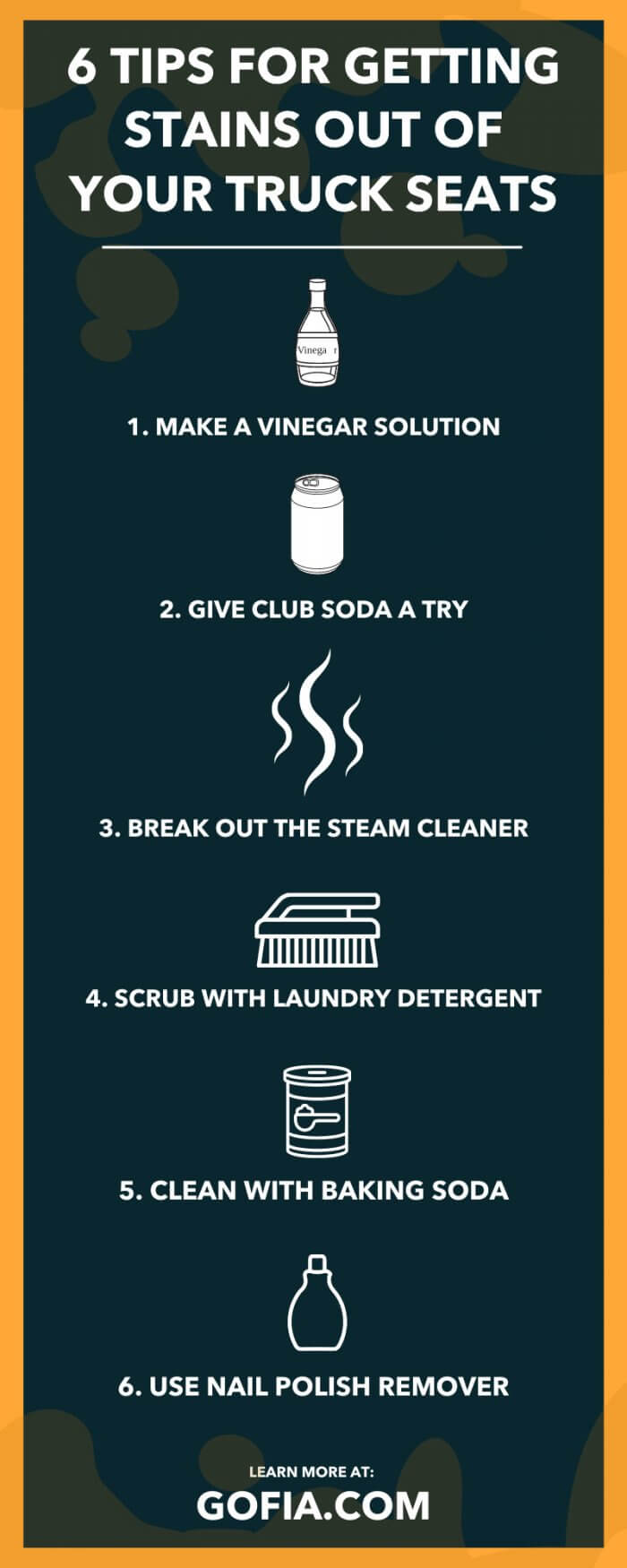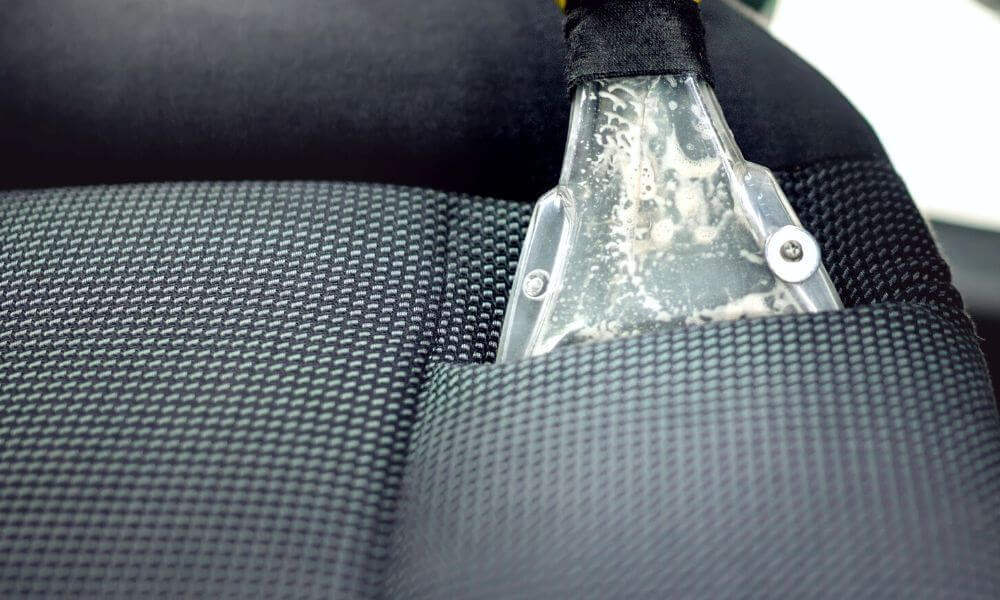For many vehicle owners, our trucks are our pride and joy. Maybe it’s your dream vehicle that you waited years to afford. Maybe it’s your first vehicle or the first one you bought brand new. Regardless, you love your truck.
That’s why finding an unexpected stain on your interior upholstery can be so frustrating, especially if you make a special point of keeping your truck clean. We understand your concern, but don’t panic just yet. Plenty of effective cleaning methods exist to scour even the most stubborn of unsightly stains. Here are our best tips for getting stains out of your truck seats.
Before Getting Started
Before whipping out the cleaning solutions, take a moment to clean out your vehicle’s interior. Throw away any trash that may have wandered its way into your cupholders and wipe down the plastic portions of your truck’s interior.
Then, thoroughly vacuum your truck’s seats. This will ensure you have a clean surface to work on and no extra grit or dirt gets smeared around in the process. Be sure to really get into the seat’s little nooks and crannies!
Once you do these general cleaning procedures, your truck’s interior is ready to receive spot stain treatment. Read on to learn various methods to remove stains from your truck’s seats.
1. Make a Vinegar Solution
First up on our list of stain removal suggestions is a DIY recipe for a vinegar solution. Vinegar can be a stronger cleaner than some store-bought products, and it doesn’t have any harmful chemicals in it—which often isn’t true with other cleaners.
Mix 1 cup of vinegar with 1 gallon of hot water. Add a splash of dish soap. Stir, and apply the solution directly to the stain. Scrub the area with a soft brush, then rinse with warm water. Use a microfiber towel to dry the spot, and leave the windows open to allow the fresh air to dry it completely.
2. Give Club Soda a Try
Is the stain still there after the vinegar method? Not to worry—we have plenty of other ideas. Pour some club soda into a spray bottle, and spray it directly onto the stained fabric. The carbonated water usually works great on small, stubborn stains.
Work the soda into the material with a soft-bristled scrub brush. Then, wipe the area down with a clean towel; the stain should have faded. Leave the windows down again and allow the spot to dry.
3. Break Out the Steam Cleaner
Sometimes, your seats just need a good steam clean to get back to their former glory. This is one of the most effective methods to remove deep-set grime and stains from your vehicle’s seats.
Steam cleaners use extremely hot water—around 245 degrees Fahrenheit—and a good deal of force to clean your seats of stains, bacteria, and mildew. If your seats are in desperate need of a deep clean, steam cleaning is the way to go. After, if the stain still isn’t gone, try using a soft-bristled brush to break up the stain. Open the windows and allow the seats to air-dry completely.
4. Scrub With Laundry Detergent
Mix a little detergent—liquid or powdered is fine—with some warm water. Pour a small amount of your detergent solution onto the seat, and remember that a little goes a long way.
Allow the solution to sit for about 10 minutes, then scrub the area with a cloth. The stain should have at least lifted slightly. Next, soak a second cloth in cold water and wipe up the remaining detergent. Roll the windows down and allow the seats to dry.
5. Clean With Baking Soda
Here’s another inexpensive but effective DIY solution. Mix warm water with a quarter of a cup of baking soda. You’ll end up with a goopy mixture—the consistency should be similar to icing. Use a spare toothbrush to apply your baking soda solution directly to the stain. Scrub with the toothbrush in circular motions. The bristles will help break up the tiny particles staining your seat and work the discoloration right out.
If the stain is really old, apply the baking soda mixture to the stain and leave it to sit for about 30 minutes before scrubbing it. Wipe up any remaining residue with a clean towel and allow the area to dry.
6. Use Nail Polish Remover
This trick is specifically for leather seats. If you have any especially stubborn stains (such as Sharpie marks), a bit of acetone nail polish remover or rubbing alcohol will get them out.
To clean, simply apply a small amount of nail polish remover to a cotton ball. Blot at the stain; it should lift quickly. Once the stain disappears, wipe off the nail polish remover with a mixture of warm water and dish soap.
Note: in some cases, nail polish removers can leave residual traces or even bleach your fabric. Be sure to keep a close eye on the solution during the application process and wipe it up completely after the stain comes up.
If All Else Fails
If none of these tips for getting stains out of your truck seats work, you may need to buy a heavy-duty upholstery cleaner from your local automotive or grocery store. Follow the directions on the packaging for proper use, but be sure to do so in a well-ventilated area. Using harsh chemicals like these in small spaces can harm your eyes and lungs.
Alternatively, you can always pay a professional to detail your vehicle. It will cost a bit more, but you can save time and trust the solution to a professional.
Preventing Truck Seat Stains
The great news is there’s an easy way to prevent truck seat stains entirely. Once you finally get that upholstery clean, we highly recommend investing in a set of truck seat covers.
Truck seat covers are much easier to clean than your vehicle’s seats. In many cases, you can simply remove the covers and toss them into the washing machine. In others, such as with our waterproof seat covers for trucks, a simple wipe-down should mop up any sticky spots.
Plus, in the event of a spill, you have the peace of mind that only your seat cover will get dirty, not your actual seat. Seat covers are far easier and cheaper to replace if cleaning doesn’t work.
If you decide to invest in a great set of seat covers for your vehicle, we have plenty of options here at Fia Inc. With a wide variety of colors and materials, you’re sure to find the perfect option for your truck.



Leave a Reply